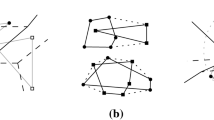Abstract
We revisit the k-nearest-neighbor (k-NN) Voronoi diagram and present a new paradigm for its construction. We introduce the k-NN Delaunay graph, which is the graph-theoretic dual of the k-NN Voronoi diagram, and use it as a base to directly compute this diagram in R 2. We implemented our paradigm in the L 1 and L ∞ metrics, using segment-dragging queries, resulting in the first output-sensitive, O((n+m)logn)-time algorithm to compute the k-NN Voronoi diagram of n points in the plane, where m is the structural complexity (size) of this diagram. We also show that the structural complexity of the k-NN Voronoi diagram in the L ∞ (equiv. L 1) metric is O(min{k(n−k),(n−k)2}). Efficient implementation of our paradigm in the L 2 (resp. L p , 1<p<∞) metric remains an open problem.









Similar content being viewed by others
References
Abellanas, M., Bose, P., Garcia, J., Hurtado, F., Nicolas, C.M., Ramos, P.A.: On structural and graph theoretic properties of higher order Delaunay graphs. Int. J. Comput. Geom. Appl. 19(6), 595–615 (2009)
Agarwal, P.K., de Berg, M., Matoušek, J., Schwarzkopf, I.: Constructing levels in arrangements and higher order Voronoi diagrams. SIAM J. Comput. 27(3), 654–667 (1998)
Agarwal, P.K., Matoušek, J.: Dynamic half-space range reporting and its applications. Algorithmica 13, 325–345 (1995)
Aggarwal, A., Guibas, L.J., Saxe, J., Shor, P.W.: A linear-time algorithm for computing Voronoi diagram of a convex polygon. Discrete Comput. Geom. 4(1), 591–604 (1984)
Alon, N., Györi, E.: The number of small semispaces of a finite set of points in the plane. J. Comb. Theory, Ser. A 41, 154–157 (1986)
Aurenhammer, F.: A new duality result concerning Voronoi diagrams. Discrete Comput. Geom. 5(1), 243–254 (1990)
Aurenhammer, F., Klein, R.: Voronoi diagrams. In: Handbook of Computational Geometry, pp. 201–290. Elsevier, Amsterdam (2000)
Aurenhammer, F., Schwarzkopf, O.: A simple on-line randomized incremental algorithm for computing higher order Voronoi diagrams. Int. J. Comput. Geom. Appl. 2(4), 363–381 (1992)
Boissonnat, J.D., Devillers, O., Teillaud, M.: A semidynamic construction of higher-order Voronoi diagrams and its randomized analysis. Algorithmica 9, 329–356 (1993)
Brodal, G.S., Jacob, R.: Dynamic planar convex hull. In: Proceeding of IEEE Symposium on Foundations of Computer Science, pp. 617–626 (2002)
Chan, T.M.: Random sampling, halfspace range reporting, and construction of (≤k)-levels in three dimensions. SIAM J. Comput. 30(2), 561–572 (1998)
Chazelle, B.: An algorithm for segment dragging and its implementation. Algorithmica 3, 205–221 (1988)
Chazelle, B., Edelsbrunner, H.: An improved algorithm for constructing kth-order Voronoi diagram. IEEE Trans. Comput. 36(11), 1349–1454 (1987)
Clarkson, K.L.: New applications of random sampling in computational geometry. Discrete Comput. Geom. 2(1), 195–222 (1987)
Clarkson, K.L., Shor, P.W.: Applications of random sampling in computational geometry, II. Discrete Comput. Geom. 4(1), 387–421 (1989)
Edelsbrunner, H., O’Rourke, J., Seidel, R.: Constructing arrangements of lines and hyperplanes with applications. SIAM J. Comput. 15(2), 341–363 (1986)
Edelsbrunner, H., Welzl, E.: Constructing belts of two-dimensional arrangements with applications. SIAM J. Comput. 15(1), 271–284 (1986)
Gudmundsson, J., Hammar, M., van Kreveld, M.: Higher order Delaunay triangulations. Comput. Geom. Theory Appl. 23(1), 85–98 (2002)
Hanan, M.: On Steiner’s problem with rectilinear distance. SIAM J. Appl. Math. 14, 255–265 (1966)
Lee, D.T.: Two-dimensional Voronoi diagrams in the L p -metric. J. ACM 27(4), 604–618 (1980)
Lee, D.T.: On k-nearest neighbor Voronoi diagrams in the plane. IEEE Trans. Comput. 31(6), 478–487 (1982)
Liu, C.-H., Papadopoulou, E., Lee, D.T.: An output-sensitive approach for the L 1/L ∞ k-nearest-neighbor Voronoi diagram. In: Proceeding of European Symposium on Algorithms, pp. 70–81 (2011)
Mitchell, J.S.B.: L 1 shortest paths among polygonal obstacles in the plane. Algorithmica 8, 55–88 (1992)
Mulmuley, K.: On levels in arrangements and Voronoi diagrams. Discrete Comput. Geom. 6(1), 307–338 (1991)
Papadopoulou, E.: Critical area computation for missing material defects in VLSI circuits. IEEE Trans. Comput.-Aided Des. Integr. Circuits Syst. 20(5), 583–597 (2001)
Papadopoulou, E.: Net-aware critical area extraction for opens in VLSI circuits via higher-order Voronoi diagrams. IEEE Trans. Comput.-Aided Des. Integr. Circuits Syst. 30(5), 704–716 (2011)
Papadopoulou, E., Lee, D.-T.: The L ∞ Voronoi diagram of segments and VLSI applications. Int. J. Comput. Geom. Appl. 11(5), 503–528 (2001)
Ramos, E.: On range reporting, ray shooting, and k-level construction. In: Proceeding of ACM Symposium on Computational Geometry, pp. 390–399 (1999)
Schmitt, D., Spehner, J.C.: Order-k Voronoi diagrams, k-sections, and k-sets. In: Proceeding of Japanese Conference on Discrete and Computational Geometry. LNCS, vol. 1763, pp. 290–304 (1998)
Shamos, M., Hoey, D.: Closest point problems. In: Proceeding of IEEE Symposium on Foundations of Computer Science, pp. 151–162 (1975)
Author information
Authors and Affiliations
Corresponding author
Additional information
A preliminary version appeared in Proc. European Symposium on Algorithms (ESA) 2011 [22]. This work was supported in part by the Swiss National Science Foundation under Grants SNF-200021-127137, and SNF-20GG21-134355, the latter under the ESF EUROCORES program EuroGIGA/VORONOI, and by the National Science Council, Taiwan under Grants Nos. NSC-99-2911-I-001-506, NSC-99-2911-I-001-511, NSC-101-2221-E-005-019-MY2, and NSC-101-2221-E-005-026-MY2.
Rights and permissions
About this article
Cite this article
Liu, CH., Papadopoulou, E. & Lee, DT. The k-Nearest-Neighbor Voronoi Diagram Revisited. Algorithmica 71, 429–449 (2015). https://doi.org/10.1007/s00453-013-9809-9
Received:
Accepted:
Published:
Issue Date:
DOI: https://doi.org/10.1007/s00453-013-9809-9




